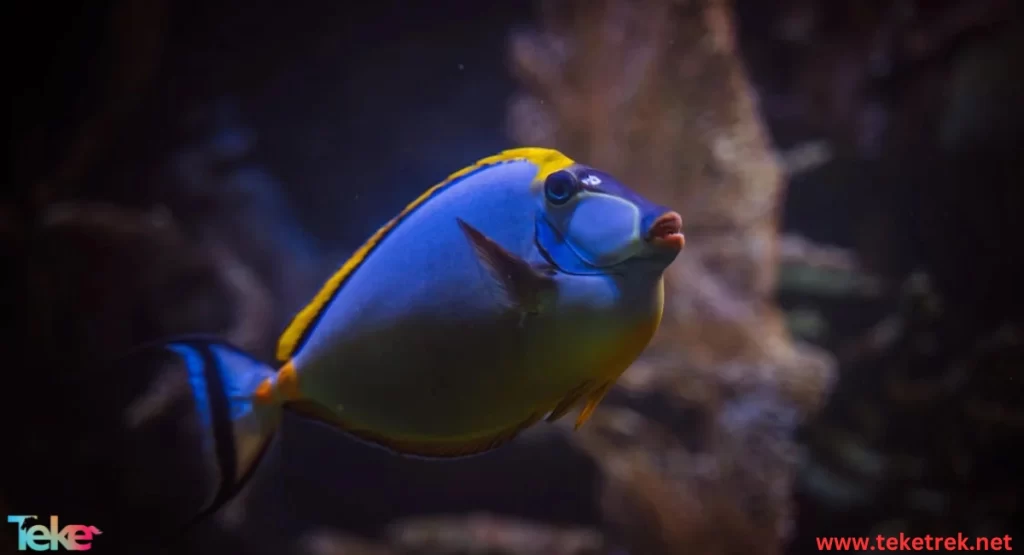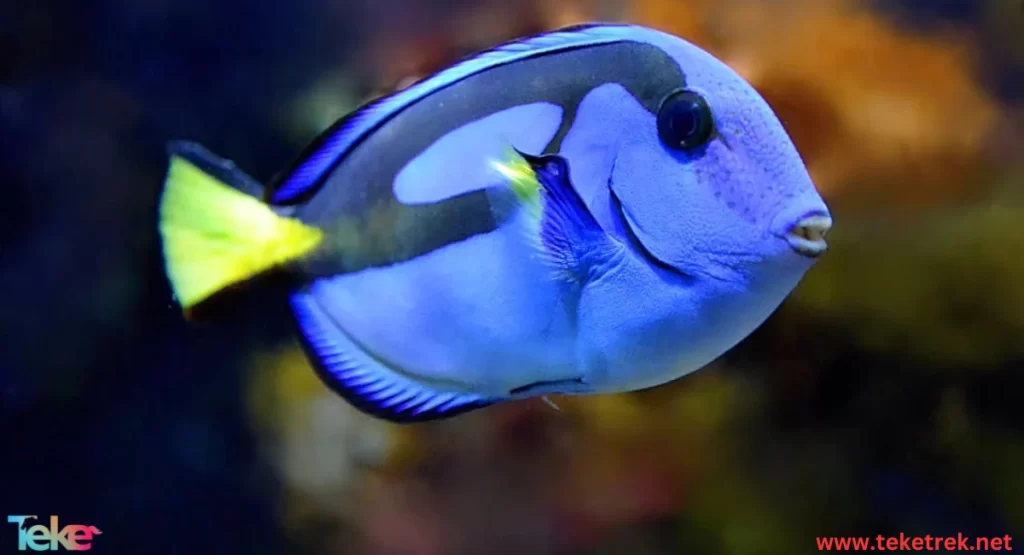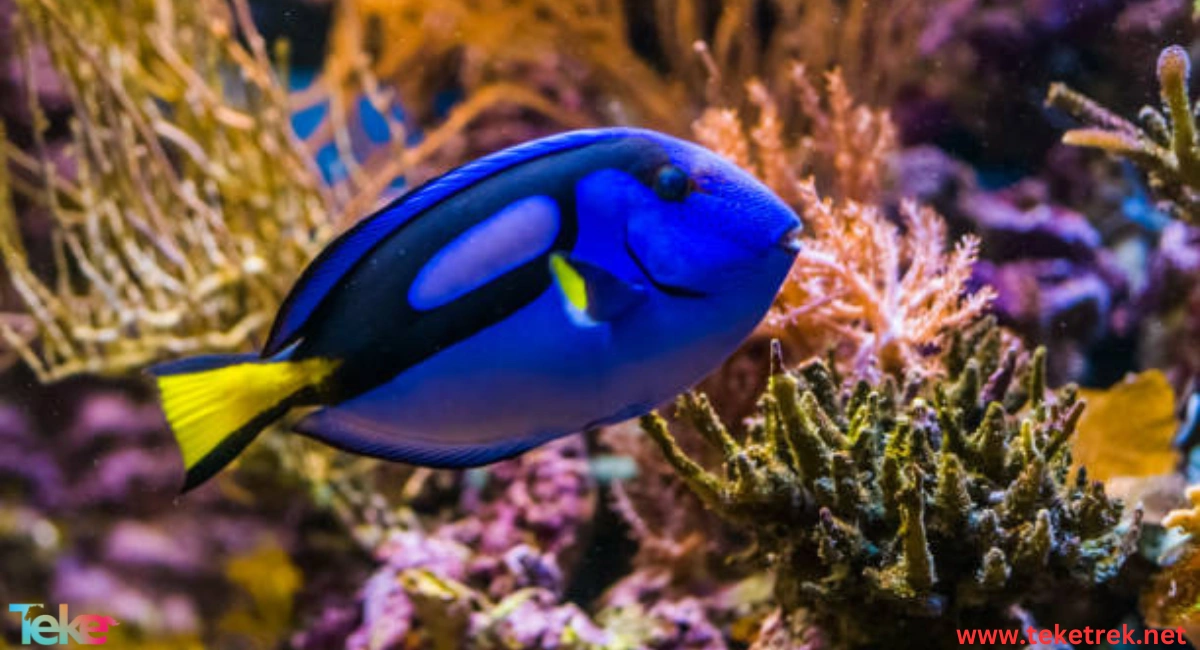It is considered one of the most beautiful types of ornamental fish.
Scientifically known as Paracanthurus hepatus, the Hippo Tang belongs to the chordate phylum and the Tang family.
Let’s learn more about it from teketrek.
Facts about The Hippo Tang Fish
It is very popular and relatively rare in the wild.
The Hippo Tang fish is classified as one of the most colorful marine creatures due to its striking blue coloration.
It has been given various names such as Royal Tang, Royal Blue Tang, and River Horse, among others.
When threatened by predators, they can feign death by lying on their side without moving until the threat passes.
Consuming this type of fish can lead to poisoning known as “Ciguatera,” with symptoms appearing within half an hour to two days, including diarrhea, low blood pressure, decreased heart rate, and potentially death.
Male Hippo Tang fish engage in combat using the spines on their tails and often emerge victorious.
Some behaviors of the Hippo Tang fish include defending itself by stabbing predators with its spines, which can be venomous.

The Hippo Tang Fish specification
The Color:
its stunning blue body color with a yellow tail and beautiful black markings.
At night, the blue color can change to a white hue tinged with purple, indicating neurological changes.
Due to ultraviolet rays, the blue color can even shift to green.
Juvenile Hippo Tang fish have bright yellow bodies with blue spots around their Eyes.
As they mature, most of their bodies turn blue with dark markings.
The Length: The length of a Hippo Tang Fish ranges from about 12 to 38 cm.
The Weight: weighing around 600 grams. Males are larger than females.
The Fins, Bones: The Hippo Tang fish has fins with sharp spines resembling scalpels and possesses 9 dorsal bones.
The dorsal fin of the Hippo Tang fish has approximately 26 to 28 transparent spines, with 3 spines in the tail.
The age: Hippo Tang fish have a long lifespan and can live for approximately 30 years.
Where do hippos live?
Hippo Tang fish can be found in pairs and groups in the Indian Ocean, the Pacific Ocean, and throughout India.
They are present in Indonesia, the Philippines, Australia, East Africa, Sri Lanka, Japan, and New Caledonia.
What do hippos eat?
Hippo Tang fish feed on plankton and algae. They play a crucial role in maintaining ecological balance by consuming algae that cover coral reefs.
Reproduction stages of Hippo Tang fish
During the mating season, Hippo Tang fish live in groups and swim upwards. They release eggs above coral reefs, with males releasing sperm.
A huge number of eggs, up to 40,000, can be released during spawning.
Spawning occurs in the late evening and early evening hours, indicated by a change in the color of the fish.
Adult Hippo Tang fish swim away, leaving the eggs behind.
Each egg contains a drop of oil to keep it afloat on the water.
After 24 hours, the eggs hatch, releasing small transparent larvae with a silver belly and primitive tail columns.
By the seventh day, the larvae begin to develop shells and intestines.
The rate of development is linked to light intensity.
The larvae mature after about 37 days, and the Hippo Tang fish reach maturity at 9 to 12 months old.

FAQs about Hippos :
How aggressive are hippos?
These fish can make themselves semi-transparent to evade predators.Featuring a yellow color with black stripes.
What are Hippos real name
Hippopotamus amphibius
: Hippos (*Hippopotamus amphibius*), also known as the common hippopotamus, Nile hippopotamus, or river hippopotamus.
What does Tang mean in fish
Tangs belong to the family Acanthuridae, a name that translates to “thorn tail,” which is why they are commonly known as “surgeonfishes.” This nickname originates from the sharp spine located on either side of their tail, which is as sharp as a surgical scalpel and should be handled with caution. In larger tangs, these spines can inflict deep cuts, much like those made by a scalpel..
Are Tang fish smart
Despite Dory’s lack-luster memory, Royal blue tangs, as a whole, are noted by numerousAquarium hobbyists regard them as intelligent and methodical animals; they have even been known to distinguish their caretakers from unfamiliar individuals..
How big does a hippo tang get
about 12″
Pacific Blue tangs can grow up to about 12 inches in length in the wild and typically reach 8-10 inches in captivity, depending on tank size and feeding conditions..
What do hippo tang fish eat
Blue hippo tangs are primarily herbivorous and require a diet rich in vegetable matter to thrive..
In conclusion, it is important to note the avoidance of such fish due to their spines that can inject venom into the body when approached. It is also important to emphasize their role in clearing coral reefs of algae by consuming them. Algae are their main food source, and they use their small teeth to scrape algae off rocks and coral reefs.
References:
wikipedia





